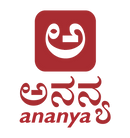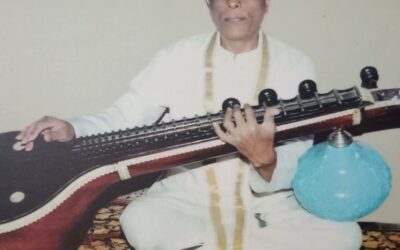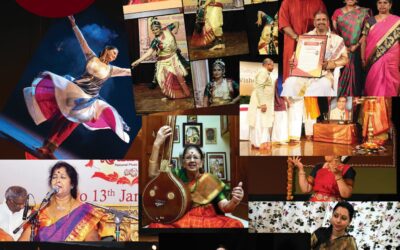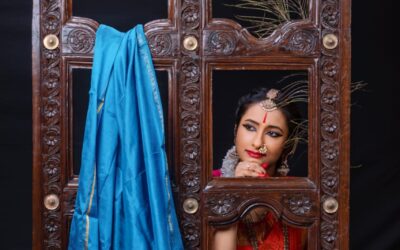The sparkle for the evening was set by Malavika Nair, the disciple of Vani Ganapathy, who rendered a sprightly Bharatanatyam performance.
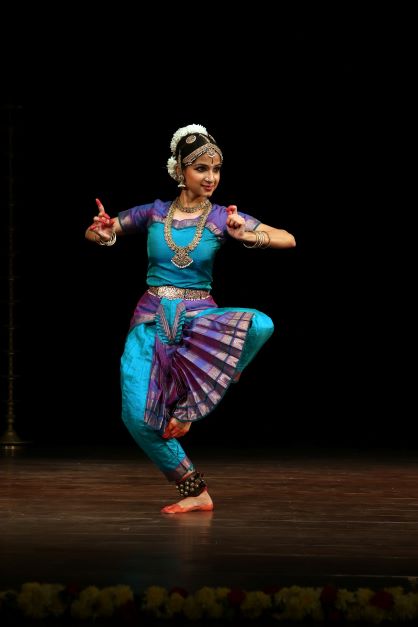 Her opening statement showcased the subjugation of the serpent Kalinga by Lord Krishna followed by the exposition of the varnam “Nee Indha Mayam”, a composition of
Her opening statement showcased the subjugation of the serpent Kalinga by Lord Krishna followed by the exposition of the varnam “Nee Indha Mayam”, a composition of Papanasan Sivan in Dhanyasi raga and Adi Tala. The narrative describes the pangs of separation of the Nayika who is deeply in love with Lord Krishna. The choreography by her Guru Vani Ganapathy provided for aesthetic interpretations of the mood and an in-depth understanding of the composition. The Nayika pleads with her Lord to shower compassion on her as she can no longer bear His indifference. The emotive expressions and the dancer’s depiction of the treatment of the torment on account of the arrows of manmadha were evocatively portrayed. The jati sequences well-choreographed and linked to the theme of the composition were executed with aplomb. The music on a recorded track embellished the proceedings.
Papanasan Sivan in Dhanyasi raga and Adi Tala. The narrative describes the pangs of separation of the Nayika who is deeply in love with Lord Krishna. The choreography by her Guru Vani Ganapathy provided for aesthetic interpretations of the mood and an in-depth understanding of the composition. The Nayika pleads with her Lord to shower compassion on her as she can no longer bear His indifference. The emotive expressions and the dancer’s depiction of the treatment of the torment on account of the arrows of manmadha were evocatively portrayed. The jati sequences well-choreographed and linked to the theme of the composition were executed with aplomb. The music on a recorded track embellished the proceedings.
She concluded with a Surdas Bhajan “Maiya Mori Main Nahin Makhan Khayo” which describes Little Krishna caught in the act of eating butter by his mother and how he uses all kinds of subterfuge to wiggle out of the situation. The playful elements of the bhajan were highlighted with verve and dexterity. Good stage presence brought out the spirit of the lyrics and the artist established her credentials as a dancer with innate talent in both Nritta and Abhinaya.
The Ananya Purushkar Award was presented to Vani Ganapathy for her outstanding contribution and commitment to the classical art form of dance. Resplendent in her attire and stature she recalled in her long acceptance speech.the origins of her early initiation into this art form. She traced the early beginnings of her dance journey and the encouragement she received from her parents, grandfather and her long association with her revered gurus starting from T.A.Rajyalakshmi to Guru Mahalingam Pillai to Guru Kalyanasusundaram and 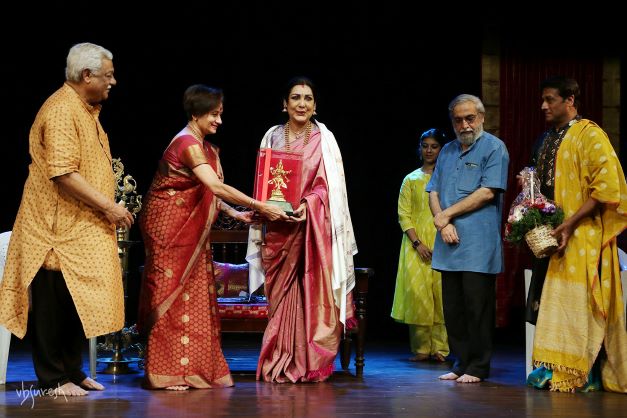 Pillai, torchbearer of the Raja Rajeswari, Kalanidhi Narayanan and her Spiritual Guru Sai. She acknowledged with gratitude the encouragement given by her mother who also sang for her performances, her sister
Pillai, torchbearer of the Raja Rajeswari, Kalanidhi Narayanan and her Spiritual Guru Sai. She acknowledged with gratitude the encouragement given by her mother who also sang for her performances, her sister Meera and Padmini. In an all-embracing acknowledgement of all the musicians, technicians, photographers and students, for their meaningful support. She also expressed gratitude to her in-laws and her friends, especially Satyanarayana Raju, R.K.Usha and Lata Bhandary.
Meera and Padmini. In an all-embracing acknowledgement of all the musicians, technicians, photographers and students, for their meaningful support. She also expressed gratitude to her in-laws and her friends, especially Satyanarayana Raju, R.K.Usha and Lata Bhandary.
Our existence has been the subject of much debate, deliberation and commentaries for several centuries. Our perception of mortal life and what exists beyond, and our yearning to reach the Absolute Truth is a chaotic journey. While enlightened saints have written about the truth of human existence in literal and metaphorical connotations, it is the words of the poet that truly capture the essence of this chaotic journey towards the Truth.
Following the award ceremony, the majesty of the poetry of Kuvempu, Da.Ra.Bendre, D.V.Gundappa and Nissar Ahmed were transformed into a movement vocabulary by the quartet of dancers -Gowri Sagar, Padmini Upadhya, PratibhaRamaswamy and Janani Murali. The composition of Kuvempu’s” Nartisu Thaye” came to life with their splendid exposition that detailed the philosophical overtones of the lyrics” Bless me with the dance of knowledge, that will be the elixir that my intellect will drink from. I realise that I must shed the layers that shroud my true self to realiseYou.I submit my body breath and mind so that your dance finds the right words in my pen”
With synergetic movements that qualified for excellent teamwork and coordination, the portrayal had the hallmark of grace, finesse and aesthetic symmetry.
The Undying Memory:
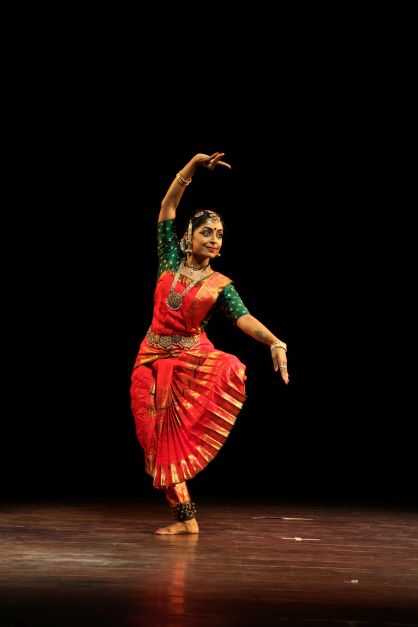 Memories-happy and sad, are part of the human psyche and haunt everyone. Some are forgotten though some memories stir up the old emotions
Memories-happy and sad, are part of the human psyche and haunt everyone. Some are forgotten though some memories stir up the old emotions
Gowri Sagar’s take on Nissar Ahmed’s “Yella Marethiruvaaga” resonated in a profound delineation that matched the high emotional intensity of expression and kinesthetics. Her body language carried the emotive expressions to their logical conclusion. Her choreographic dexterity, punctuated with a fine blend of aesthetic interpretation and depth of understanding of the poet’s metaphorical connotations personified her expressions to qualify for a delightful and absorbing rendition. The poetry popularised byRatnamala Prakash and rendered by Meghana Kulkarni added sensitivity and bhava to the presentation. The music ensemble comprising Karthik Sathavali on the flute, and vidwan Lakshminarayana on the mridanga,kanjira and morching complemented and enriched the proceedings
Padmini Upadhya presented “Natanvadidal Taruni’, a poem by D.V.Gundappa that speaks of the rigours of life, the harsh realities of human greed, hierarchy and power play begin to  shroud the truth. For the woman to shed the weight of the past and clear her path ahead, every individual must attain such perceptive clarity. Is it possible? Ask the kuravanji. Holding a damaru in one hand and a flute in the other, she walks through the world and can look at the journeys of fellow travellers. Performing the Tandava of Shiva and sometimes the playful Raas of Krishna at others, this madanika of the BelurTemple who dismisses herself as a kuravanji holds in this disguise many truths. Ultimately she is is the dasi of Chennakeshava.
shroud the truth. For the woman to shed the weight of the past and clear her path ahead, every individual must attain such perceptive clarity. Is it possible? Ask the kuravanji. Holding a damaru in one hand and a flute in the other, she walks through the world and can look at the journeys of fellow travellers. Performing the Tandava of Shiva and sometimes the playful Raas of Krishna at others, this madanika of the BelurTemple who dismisses herself as a kuravanji holds in this disguise many truths. Ultimately she is is the dasi of Chennakeshava.
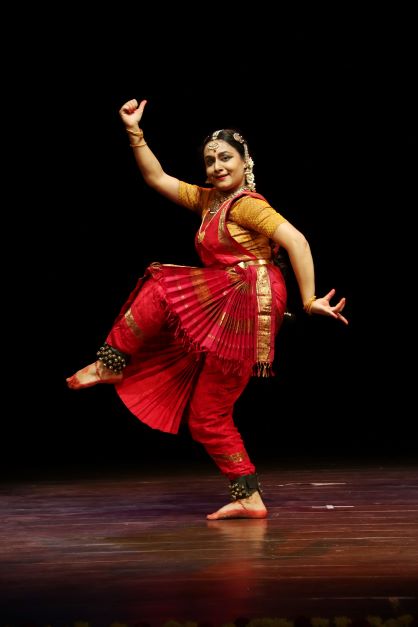 Padmini Upadhya in her role play as the kuravanji provided a free-flowing, poignant and energetic exposition. Her performance provided a visual delight highlighting the choreography with an emphasis on rhythm and sensitive abhinaya and flair for pure dance. Adding verve to her presentation was her dignified grace and stage presence The artistically sensitive improvisation on stage provided the lyrical grandeur to the flow of the narrative.
Padmini Upadhya in her role play as the kuravanji provided a free-flowing, poignant and energetic exposition. Her performance provided a visual delight highlighting the choreography with an emphasis on rhythm and sensitive abhinaya and flair for pure dance. Adding verve to her presentation was her dignified grace and stage presence The artistically sensitive improvisation on stage provided the lyrical grandeur to the flow of the narrative.
Antarangada Mrudanga -Da Ra Bendre.
We live an infinite number of lives until we can be freed from the cycle of birth and death. The gatekeepers of Vishnu, the divine Jaya and Vijaya, had to endure mortal existence to realise Vishnu. Through each of their lifetimes on earth, they live as enemies of Vishnu but the moment of truth at the time of each mortal death takes them closer to Vishnu.Through the metaphor of Hiranyaksha and Hiranyakashipu, Ravana and Kumbakarna, Shishupala and Dantavakra the verses of Da.Ra. Bendre resonate. Pratibha Ramaswamy and Janani Murali performed this piece with delightful synchronization and strong technique, that invested every sequence of their enactment of the storyline with intensity and synchronised artistry. The portrayal was punctuated with expressive anecdotes of Hiranyaksha, Hiranayakashipu, Ravana and Kumbakarna, Shishupala and Dantavakra. The narrative stood out for its impeccable execution that was profound and impactful and aligned to the verses in the composition.
Vishnu. Through each of their lifetimes on earth, they live as enemies of Vishnu but the moment of truth at the time of each mortal death takes them closer to Vishnu.Through the metaphor of Hiranyaksha and Hiranyakashipu, Ravana and Kumbakarna, Shishupala and Dantavakra the verses of Da.Ra. Bendre resonate. Pratibha Ramaswamy and Janani Murali performed this piece with delightful synchronization and strong technique, that invested every sequence of their enactment of the storyline with intensity and synchronised artistry. The portrayal was punctuated with expressive anecdotes of Hiranyaksha, Hiranayakashipu, Ravana and Kumbakarna, Shishupala and Dantavakra. The narrative stood out for its impeccable execution that was profound and impactful and aligned to the verses in the composition.
The music on a recorded track with Raghuram (vocal), Srihari Rangaswamy (rhythm composition and percussion), Mahesh Swamy (flute) added flair to their presentation.
The duo culminated their performance with a prayer of hope composed by Da.Ra.Bendre
